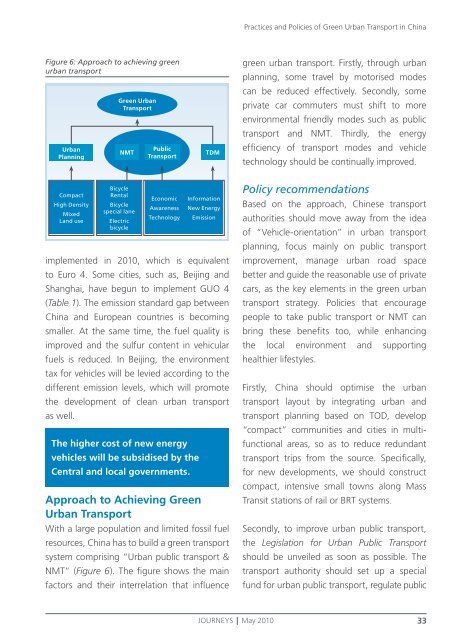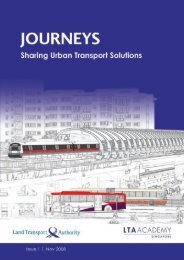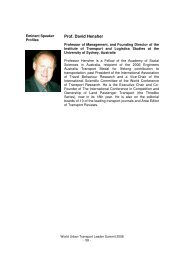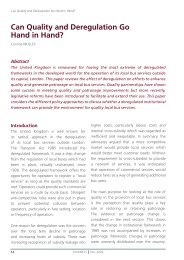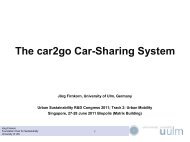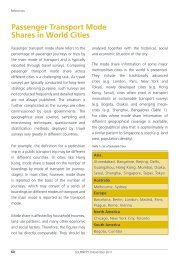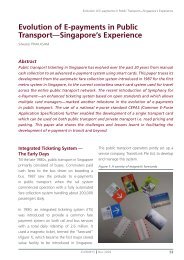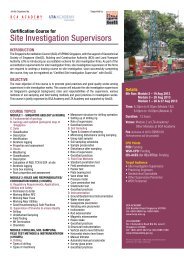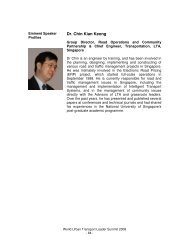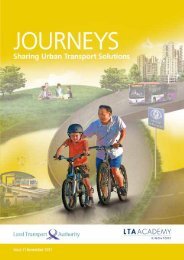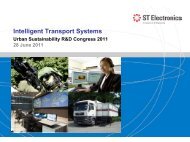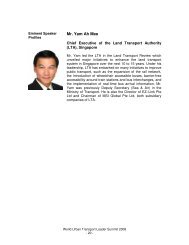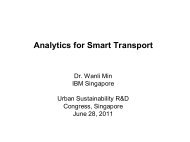Issue 4 May 2010 - LTA Academy
Issue 4 May 2010 - LTA Academy
Issue 4 May 2010 - LTA Academy
You also want an ePaper? Increase the reach of your titles
YUMPU automatically turns print PDFs into web optimized ePapers that Google loves.
Figure 6: Approach to achieving green<br />
urban transport<br />
Urban<br />
Planning<br />
Compact<br />
High Density<br />
Mixed<br />
Land use<br />
Green Urban<br />
Transport<br />
NMT<br />
Bicycle<br />
Rental<br />
Bicycle<br />
special lane<br />
Electric<br />
bicycle<br />
Public<br />
Transport<br />
Economic<br />
Awareness<br />
Technology<br />
implemented in <strong>2010</strong>, which is equivalent<br />
to Euro 4. Some cities, such as, Beijing and<br />
Shanghai, have begun to implement GUO 4<br />
(Table 1). The emission standard gap between<br />
China and European countries is becoming<br />
smaller. At the same time, the fuel quality is<br />
improved and the sulfur content in vehicular<br />
fuels is reduced. In Beijing, the environment<br />
tax for vehicles will be levied according to the<br />
different emission levels, which will promote<br />
the development of clean urban transport<br />
as well.<br />
The higher cost of new energy<br />
vehicles will be subsidised by the<br />
Central and local governments.<br />
TDM<br />
Information<br />
New Energy<br />
Emission<br />
Approach to Achieving Green<br />
Urban Transport<br />
With a large population and limited fossil fuel<br />
resources, China has to build a green transport<br />
system comprising “Urban public transport &<br />
NMT” (Figure 6). The figure shows the main<br />
factors and their interrelation that influence<br />
Practices and Policies of Green Urban Transport in China<br />
green urban transport. Firstly, through urban<br />
planning, some travel by motorised modes<br />
can be reduced effectively. Secondly, some<br />
private car commuters must shift to more<br />
environmental friendly modes such as public<br />
transport and NMT. Thirdly, the energy<br />
efficiency of transport modes and vehicle<br />
technology should be continually improved.<br />
Policy recommendations<br />
Based on the approach, Chinese transport<br />
authorities should move away from the idea<br />
of “Vehicle-orientation” in urban transport<br />
planning, focus mainly on public transport<br />
improvement, manage urban road space<br />
better and guide the reasonable use of private<br />
cars, as the key elements in the green urban<br />
transport strategy. Policies that encourage<br />
people to take public transport or NMT can<br />
bring these benefits too, while enhancing<br />
the local environment and supporting<br />
healthier lifestyles.<br />
Firstly, China should optimise the urban<br />
transport layout by integrating urban and<br />
transport planning based on TOD, develop<br />
“compact” communities and cities in multifunctional<br />
areas, so as to reduce redundant<br />
transport trips from the source. Specifically,<br />
for new developments, we should construct<br />
compact, intensive small towns along Mass<br />
Transit stations of rail or BRT systems.<br />
Secondly, to improve urban public transport,<br />
the Legislation for Urban Public Transport<br />
should be unveiled as soon as possible. The<br />
transport authority should set up a special<br />
fund for urban public transport, regulate public<br />
JOURNEYS <strong>May</strong> <strong>2010</strong> 33


